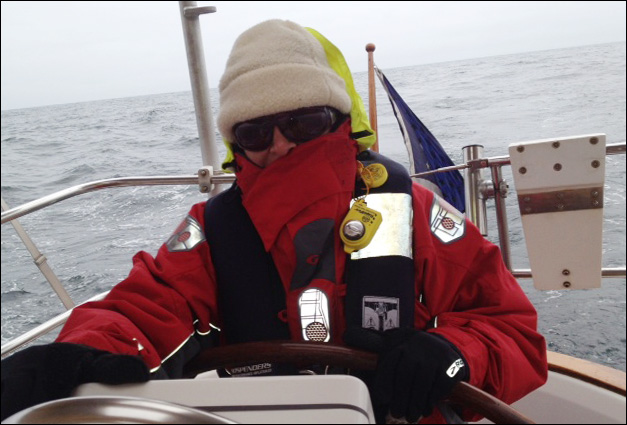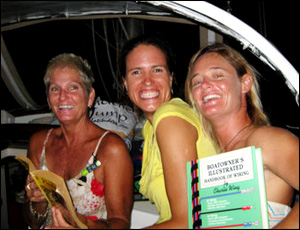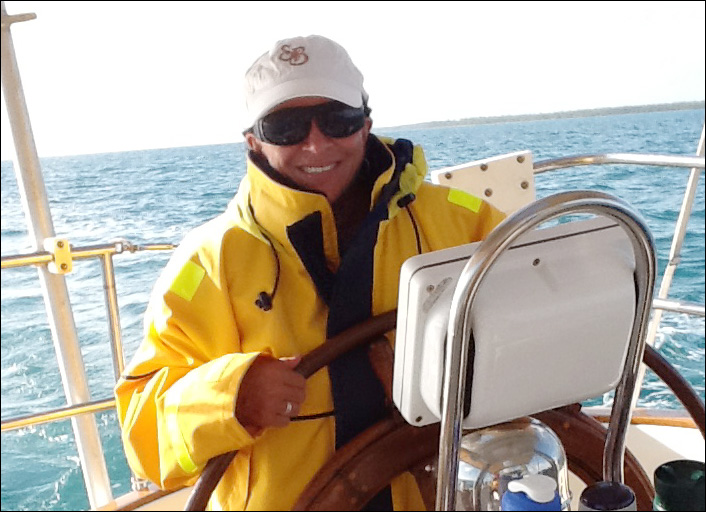 |
| Susan at the helm after the storm |
A couple of years ago when my husband gave me a copy of Beth Leonard’s book, “Following Seas”, with the caveat that I probably shouldn’t read the first chapter, I might have known that sailing would have some adventures in store. But our story started long before that; it really started 8 years ago on Long Island Sound.
After a mutual friend of our daughter’s decided we should meet, I was invited for a sail on Phil’s 28’ Shannon cutter, Inseparable. Keep in mind that my sailing experience consisted of twice sitting in the cockpit of a friend’s 40’ boat on Lake Huron sipping wine and enjoying the sunshine. I agreed to the date a bit reluctantly.
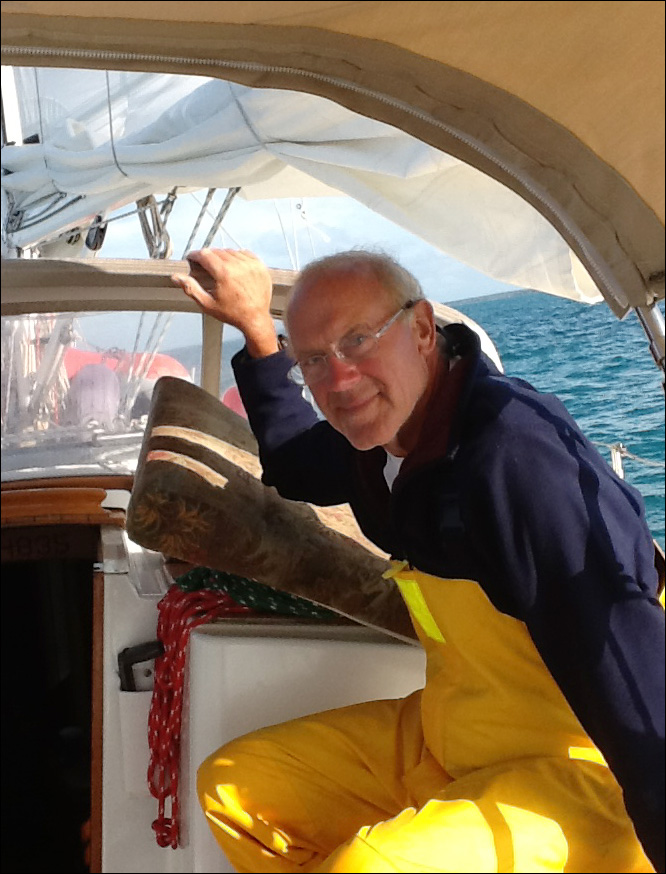 |
| Phil |
Following his thorough briefing on safety features and how to use the VHF’s automatic Mayday button (I hoped I’d never have to use that on a first date!), we left the security of his Noank, Connecticut slip in bright sun and light wind. After a while, he let me take the tiller.
A short time later, he lay down on a cockpit cushion. It was now up to me to guide us through the sea of lobster buoys, aids to navigation and a plethora of boats of every description that occupy Fishers Island Sound on a summer weekend afternoon.
At one point, I told him there was a buoy dead ahead to which he replied, “Just don’t hit it.” He thought I meant a navigation buoy, not a lobster buoy. What did I know about navigation buoys? Nothing.
In my ignorance, I glided right over the lobster buoy and promptly wedged the warp between our rudder and keel. Oops….I told Phil I didn’t think we were moving. He got up and to his dismay, saw a bright orange buoy bobbing under the boat.
After much discussion I finally convinced him to let me jump over and free us of this irritation. After all, I reasoned, I was a certified scuba diver, was in the best shape of my life thanks to six months of triathlon training plus I had no clue how to sail Inseparable back to pick him up if he’d successfully dislodged us. So over I jumped in my shorts and tank top, but not before he secured me to the boat with a long line. I was unsuccessful but eventually we were assisted by a passing lobster boat and that, in a clamshell, is when we fell in love. In fact, the lobster buoy now graces our mailbox. Now to the real story.
That day lead to our marriage and years of sailing out of our home port, Portland, Maine. With a variety of on-the-water experiences (one can have a lot of those in a 28’ boat with a 13 HP engine in the Maine waters) and his patient teaching I developed a lot of confidence on the boat. I also learned to varnish the extensive woodwork, scrub everything that didn’t move, cook out of a miniature galley and distinguish a rope from a line and a bathroom from a head. Most of all, I learned I loved sailing and our time at sea.
We found our usual weekend and two-week explorations of the Maine coast were just not enough. Phil wanted to cross the pond. I wanted to cruise with friends and family. Thus began our search for a larger vessel. We researched the literature and internet, queried experienced cruisers and visited many boats for sale. We weighed the advantages of center versus aft cockpits and comfort versus heavy weather capability. In my naiveté, I never thought for one minute we would need heavy weather capability. My vision was being in a hammock strung between the mast and the forestay! I admit I was tempted by those boats with large master cabins, ‘real’ beds, and modern galleys. In the end, safety was the feature that made us settle on another Shannon built, cutter rigged, aft cockpit, bluewater boat.
We found the perfect specimen in northern Florida. After a number of upgrades, we sailed her down the coast of Florida in late February and to the Bahamas for the balance of the winter. Every day brought new experiences, lessons and discoveries. I felt most intimidated when trying to dock her in various conditions. It was a big change for me especially judging where the front of the boat actually was. At 5’1”, I’m challenged a bit, especially when the dinghy is loaded on the front of the boat. I have been promised a stool or seat one of these days.
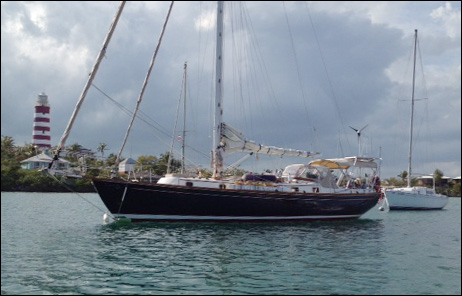 |
| STILL INSEPARABLE in Hopetown Harbor |
We decided to sail directly back to New Hampshire on a straight line north from the Abacos in early May with two friends who both had extensive offshore experience. This trip was to be my first true offshore voyage. I seemed prepared and felt comfort knowing that I was in the company of three experienced sailors. Our departure was set and even though the forecast was for 30-35 kt winds, it was nothing our boat couldn’t handle. We had contracted with a weather service via our SSB and had set a time to check in with friends back in the islands. We set out in bright sunshine. Although I’m not prone to seasickness, I put on a scopolamine patch just in case.
Two hours into the voyage, the sea and wind started to kick up. Sadly, I was the first to ‘chum’ overboard, totally embarrassing myself, or so I thought. Visions of a planned shrimp scampi dinner our first night at sea rapidly disappeared. The wind continued to build as did the waves and soon, even Phil and Charlie surrendered to seasickness. Of note here is that Phil has never been seasick since owning his own boat. Charlie spent four years sailing the world back in the 70’s.
Caro, our second crew member, sailed across the Atlantic in a hurricane. Fortunately for us, she had a stomach of iron. She was also an extremely able helmsperson, who as the storm continued to build and as the men got sicker, taught me how to steer up and down those gigantic waves.
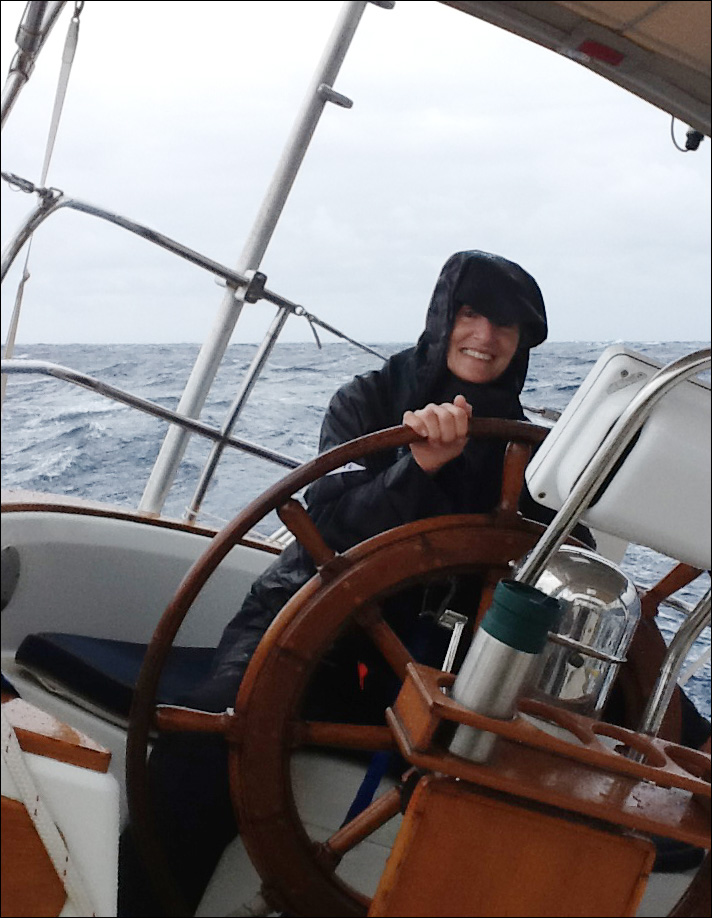 |
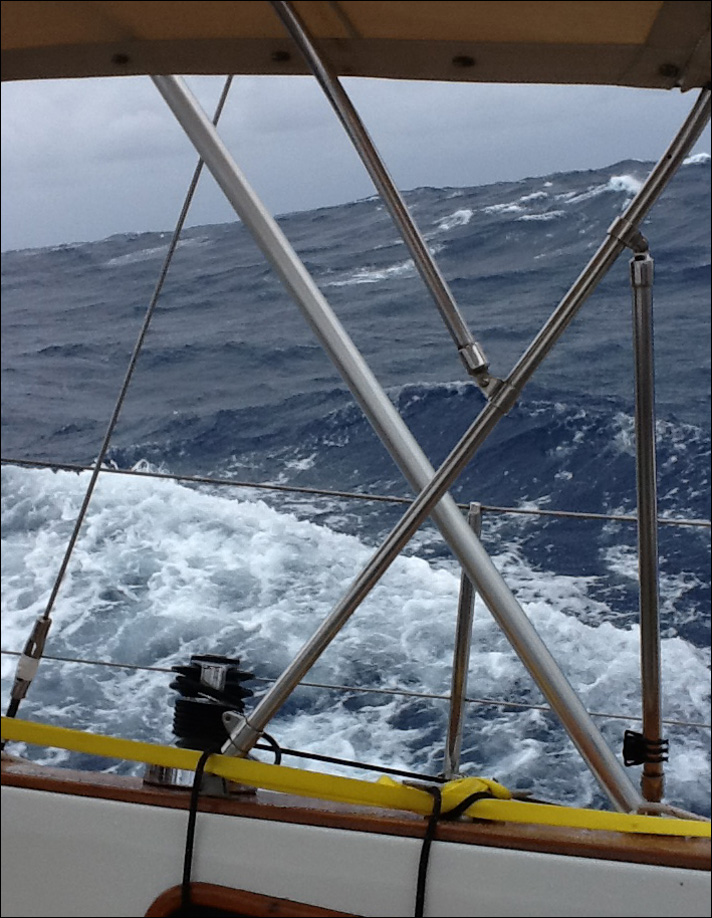 |
|
| Crewmember Caro at helm | Waves at the beginning of the storm |
I had no idea that the ‘feel’ of the boat was something that really can’t be taught. One learns quickly to be responsible for the lives of the rest of the crew. As I steered up the 20’ waves that were hitting our port side, I felt the power of the sea and the ability of our boat to rise up and ease down safely. You have no time to panic or retreat to the cabin with covers over your head and hope it all goes away (yes, I was tempted…..). Under my hands, I could feel the water move the rudder and each time it did, I sensed the touch on the wheel that the boat needed.
We checked in frequently with friends in Hope Town. After 36 hours we found the storm had increased in size and intensity. At this point, both men could not even keep down water despite scopolamine patches, so Caro and I did most of the steering and navigating. Cooking was out of the question, but no one had much of an appetite.
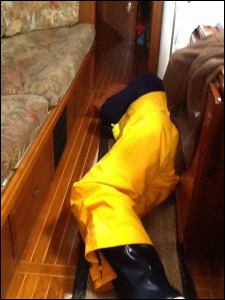 |
| The best place to sleep in astorm |
Below decks became a place to ‘crash’ – our starboard sea berth held one of us and the other, usually Phil or I, made the floor our place of retreat as it was the most stable part of the boat; sleeping in the v-berth was not an option. Somehow, Caro made the aft cabin her off-watch sanctuary.
Talk on the SSB became an effort. I draped my head horizontally over the nav station to avoid being sick. Changing clothes was unthinkable; survival became the mode of operation for all of us, except of course for Caro who cheerfully took the helm without a backward glance at those huge monster waves that loomed in the night. Yes, she really did smile through a lot of this. In fact, she really enjoyed herself.
After 48 hours and a short discussion between Caro, Phil and myself (Charlie was blissfully asleep.), the decision was made to turn back, restore ourselves, make the necessary boat repairs and start again. Surprisingly, after another 24 hours heading south, the storm subsided and voila, the sun came out and all was right with the world. Taking stock of the damage to the boat, we only had one extremely chafed reefing line, one broken bow nav light, and one lost outboard motor. We laughed over that one….no one knew it was missing until the second day of the storm. Our heavy dinghy motor now sits at the bottom of the Atlantic.
What did I learn from all this?
- First, all the years of safety training paid off. More importantly, I no longer have any doubt about how the boat will handle heavy weather. Even though we found leaks here and there, she was a sturdy force against the storm. That fact alone made the ordeal easier to face.
- I feel if I have confidence in your boat, the crew and my own sailing ability, I am able to rise above my fear and carry out any necessary tasks. I had no time to think about being afraid as loved ones needed me to be at my best.
- Third, after surviving a gale, I’m much less afraid of weather at sea while, at the same time, I’m much more respectful of what it can be. It was the best learning experience. As Beth Leonard said, you get back on the boat because that 1% bad weather you experience won’t come around again anytime soon….you hope.
Of course, I kissed the ground when we arrived back in the Abacos. Today we can laugh at some of our antics.
The following passage taken from my journal is of our thwarted first attempt at going home described above. It makes for amusing reading:
Day1 2100
Every crew member except Caro has puked at least once. 20-25 kt winds with 8-15′ swells or waves…at this stage nomenclature isn’t important. Raining intermittently. Too sick to write in log. Down from one reef main, staysail and Yankee to two reefed main. Shrimp scampi dinner postponed. Water and crackers are on the menu. And this is fun?
Day 2 0900
Diane and Jan are saviors….they repeatedly checked the weather and advised us to turn around. Wind is consistently above 35, waves 20′ like big monsters in the night. Phil and Charlie can’t even keep down water; Caro and I manage. Can’t be vertical below decks; floor is the place to sleep. Haven’t changed clothes and really don’t care.
Day 3 1300
Turned around; now into the wind and waves are just as big.”
Top 10 hints I learned from Offshore Sailing
- Dry clothes trumps clean anytime.
- Any small object on the deck has a magnet for toes; expect to have a few broken ones before the trip is over.
- Scopolamine patches are not over rated.
- Baked potatoes for breakfast sound perfectly reasonable.
- It is possible not to eat for 72 hours and feel good about it.
- Anything that gets wet after Day 1 stays wet.
- A soggy wet blanket is better than no blanket.
- Ski goggles come in handy.
- You can use a bathing suit and a down jacket one day apart.
- You witness the power, majesty, and beauty of the sea firsthand.
About Susan Von Hemert
Susan and her husband live in Portsmouth NH where Phil is retired and Susan owns a consulting business servicing medical equipment companies. They enjoy travels to visit their four married daughters and eight grandchildren and hope to spend much of the next several years sailing. Still Inseparable regularly sails the Maine coast in the summer.
Susan’s first love on board is cooking; recipe books supply great nighttime reading. Making yogurt and sprouts have now become regular additions to her galley routine.
Their website is www.sailingstillinseparable.com.
